My childhood in Jeddah, Saudi Arabia, during the 1980s, was an eclectic idyll: a pastiche of roller discos and pool parties, monthly road trips to the Great Mosque in Makkah (Mecca), Brownies meetings, spelling bees, and shopping at ancient souks until 2 a.m. Inside my family’s expat compound, a sprawling gated community with tidy subdivisions and manicured lawns, life unfolded in a bubble; it could have been the small town in Ontario, Canada, where I was born. Outside its gates, certain limitations were simply facts of life: My mother never drove, restaurant guests were segregated by gender, and because of a ban on cinemas,1 visits to movie theaters were reserved for our trips to the States or India.

The Jeddah I grew up in is a distant memory, with the sprawling Vision 20302 road map rolling out ambitious reforms to the Saudi economy, infrastructure, and society—and, in the process, transforming the way the cloistered kingdom has operated for decades. Businesses are no longer required to separate customers by gender; film and music industries are booming; and women have the right to drive, hold their own passports, and travel domestically without a male escort.3 Since 2019, the Saudi religious police—who once patrolled public areas to enforce the observance of Islamic law—have been largely stripped of power.
A key element of the Vision 2030 plan has been investing in tourism, by transforming long-neglected heritage sites, carving futuristic cities out of swaths of desert, and making the country easily accessible to foreigners for the first time. It’s surreal seeing Saudi Arabia advertised on splashy billboards everywhere from Dubai to New York, but on my visits back to the kingdom in recent years, I’ve been awed less by the flamboyant new additions—star-studded concerts,4 film festivals, striking architectural marvels—than by the effect its social transition has had on the fabric of everyday life.
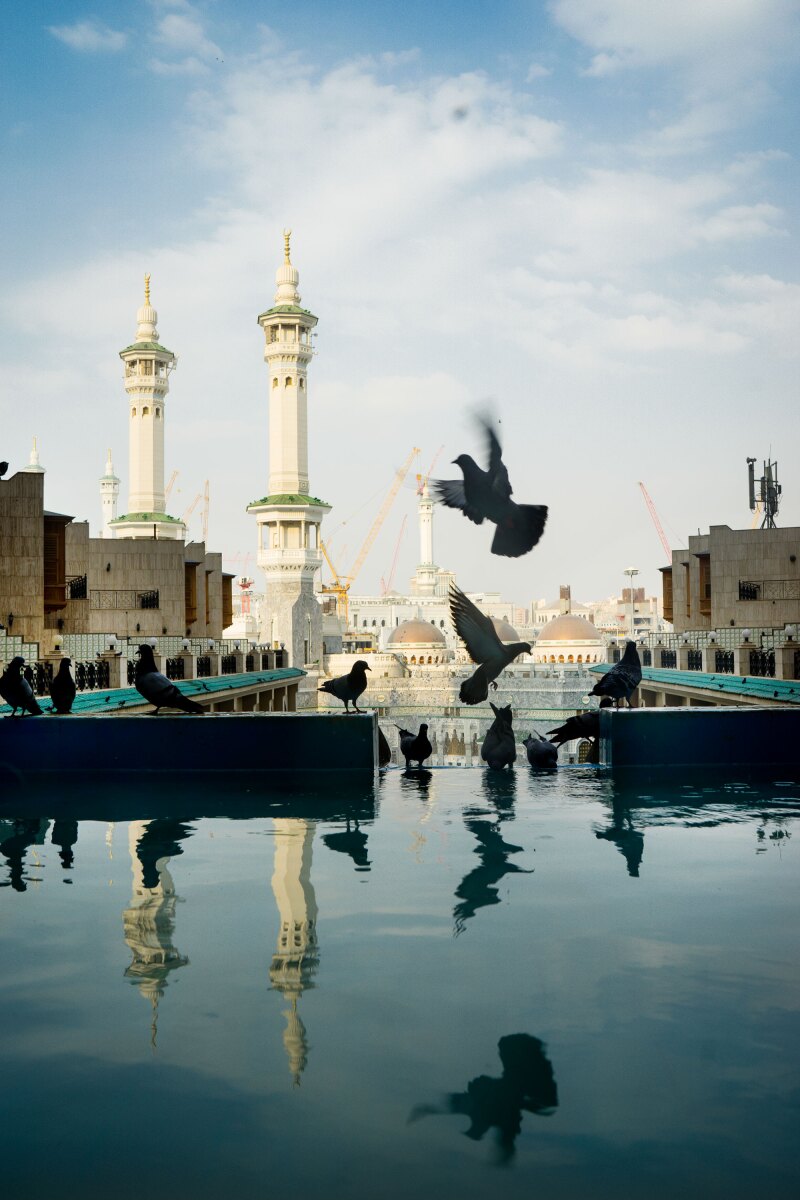
A view of the Great Mosque in Makkah (Mecca), Islam’s holiest city. It is believed to be the birthplace of the Prophet Muhammad.
Photo by Tasneem Alsultan

During trips in the past year, I’ve hired women tour guides and interviewed women fashion designers. A woman wearing a niqab5 stamped my passport to welcome me back to Jeddah, and friends have told me about being driven home by women Uber drivers. There are still strides to be made,6 but women are engaged in public life in a way I never witnessed in my childhood.
No one has chronicled the nation’s evolution more thoughtfully than photographer Tasneem Alsultan. Whether she’s riding with women motorcycle enthusiasts in Riyadh or capturing the quotidian pleasures experienced by Saudi families, Tasneem manages to slow the breakneck speed of change into moments of contemplation frozen in time. Our journeys in the country diverged: I was a Canadian raised in Jeddah during my formative years, while Tasneem was a Saudi who grew up in the United States and England before returning to the kingdom as a young woman. We spoke about our experiences in Saudi Arabia’s future-focused present7 and her approach to documenting it.
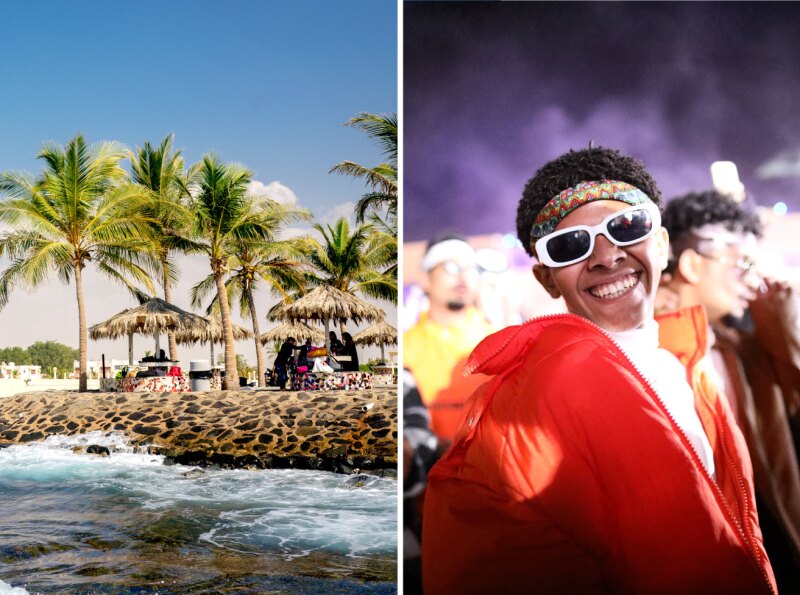
Left: Families gather at one of Jeddah’s private beaches on the Saudi side of the Red Sea. Some are for members only, while others offer day passes to visitors. Right: A concertgoer enjoys Riyadh’s MDLBeast Soundstorm festival. Launched in 2019, the festival spans three days, includes more than 150 artists, and draws roughly 450,000 visitors.
Photos by Tasneem Alsultan
Sarah Khan: I’m curious. How did you become a photographer?
Tasneem Alsultan: I really enjoyed photography, but I never expected I would be able to do it professionally. When I went to King Abdulaziz University8 in 2002, there was not even graphic design—but there was home management! My bachelor’s is in English literature and linguistics, and my master’s degree is in social anthropology and social linguistics from Portland State [in Oregon].
When I moved back to Saudi in 2008, I couldn’t find a job. My mom said, “You have a camera: photograph whatever you see, just to keep busy.” And I did. Very quickly, I gained a large audience on Facebook, and when I got a job at a university in Bahrain, I opened a studio. Later, I moved to Dubai to teach, but most of my time was consumed with photography. I realized I loved it so much more than being a lecturer. So I quit teaching, and I’ve never looked back.
Sarah: Today the creative scene has come such a long way from when you started. In the past five years alone, it feels like a different country every time I return. Yet what I find interesting is that Jeddah is visually the same—it’s the feeling, the vibe, that seems to be different.

Tasneem: I agree. Jeddah is aesthetically slow to change. But in mindset, it depends on who you are. As much as the government9 is trying to change things, it’s happening so fast that I think, in the next five years, more people will see, “Oh, this is [the new] normal.” The younger generation10 has more confidence in asking for more concerts, more outdoor areas. We want to wear what we’re comfortable in. These changes have made the country great for my daughters, who are 17 and 15, whereas my generation was expected to just keep our thoughts to ourselves and not really push back on our families and society.

Clockwise, from top left: Iftar, a meal eaten after sunset during Ramadan, often includes sweet and savory offerings. Friends and family gather to break their fast, then start prayer; Iraqi women who recently completed a pilgrimage to Makkah stop along Jeddah’s 18-mile waterfront; A traveler walks at Al-Hijr—also known as Hegra and Mada’in Salih—an ancient archaeological site of carved tombs and monuments. In 2008, it became the first Saudi Arabian location to be inscribed as a UNESCO World Heritage site. The country now has six properties on the World Heritage List.
Photos by Tasneem Alsultan
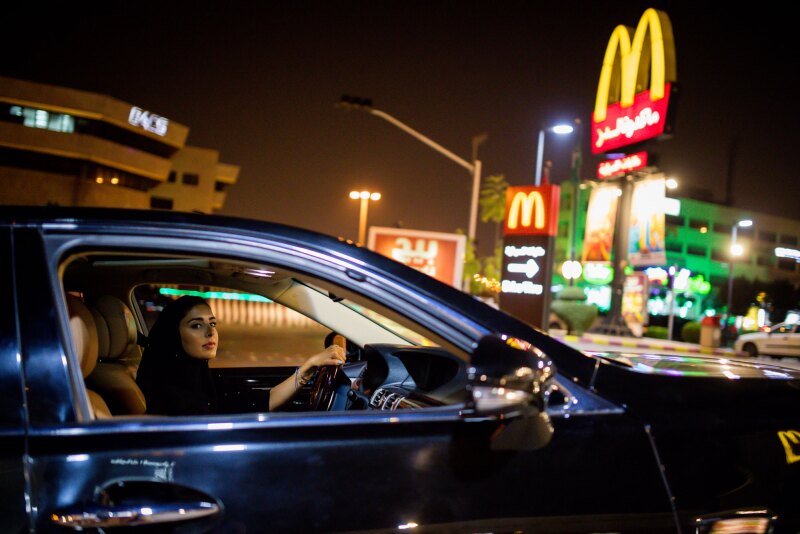
Hessah took to the road the day the driving ban was officially lifted. Her first stop: McDonald’s.
Photo by Tasneem Alsultan
Sarah: When you’re photographing this type of social change, what are you looking for? What draws your eye?
Tasneem: I’m aiming to capture a moment that’s mundane but important. Change happens in a superficial way when it’s architecture, or when it’s an event. But I try to photograph when people are happy or in shock. I like sharing perspective on Saudi Arabia: the first time women were allowed to enter a cinema in Saudi, and they’re eating popcorn; the woman driving a car, with a McDonald’s11 in the background.
Sarah: I was in Makkah12 in 2017, and I was talking to a woman who said, “We all drive when we go overseas. But drivers in Saudi are crazy, so I don’t mind not driving.” It felt a bit like a rationalization. It’s been almost five years since the ban13 was lifted. What’s it like now?

Tasneem: I was one of those women who never wanted to drive in Saudi because of the roads, the drivers, the cars—like you said, I rationalized it. And now that I’ve been driving, I don’t remember or realize how there was a world where women couldn’t drive. It was such a big issue. The most important one was emotional, feeling like you don’t deserve to be in control of your own life. It’s important for women to have all the same rights because sometimes society governs us more than governments or religions do.
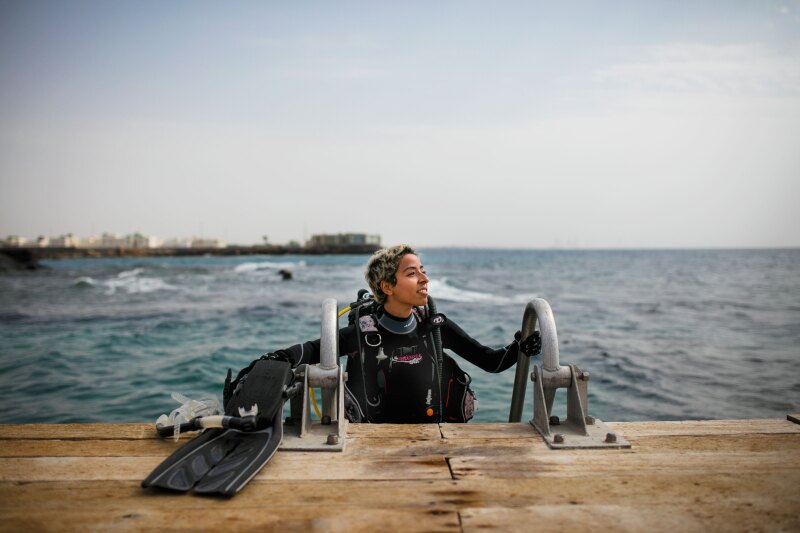
Ouhood, photographed before the driving ban was lifted in 2018, said she felt alive under water. “We can’t drive, but we can dive,” she said.
Photo by Tasneem Alsultan
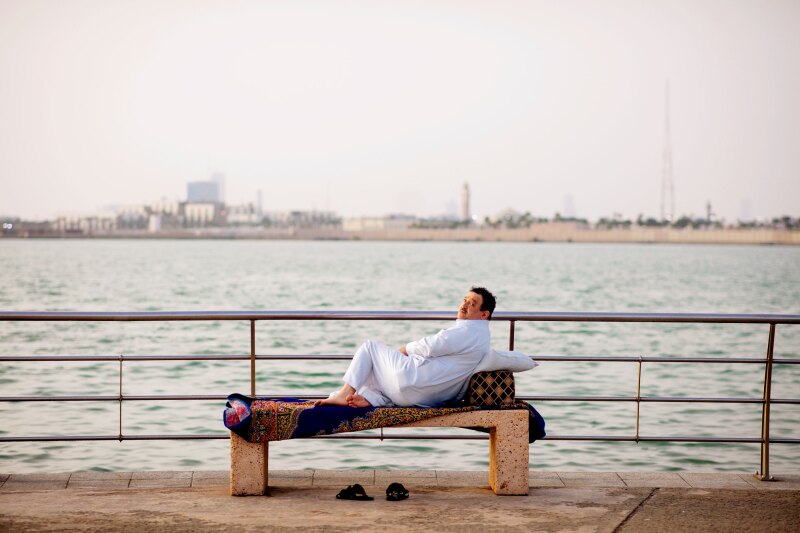
Also known as the Jeddah Corniche, the waterfront hugs the Red Sea.
Photo by Tasneem Alsultan
Sarah: One of those tropes you hear about countries is “The locals are so friendly.” Now that the kingdom is opening up to tourists, do you think Saudis are excited to have visitors they can show their country to?
Tasneem: Saudis are very intrigued by foreign visitors, like, “Wow, you came to Saudi, of all places? What brought you here?” There’s excitement. As a society, we have so much that we want the world to see. There’s just never been that access. In Western media before, we were either victims—women, especially—or we were villains, especially men. So I’m very happy to have this conversation14 and dialogue, even if it’s visually, which I think is more authentic. My work is not altered. And it’s important for the world to see our normal, daily lives.

Sarah: Do you feel like the Saudi Arabia being promoted to international tourists is authentic to your experience as a Saudi?
Tasneem: They have all these taglines—Umluj is “the Maldives of Arabia.” It sounds very cliché, until you go and see it, and then you’re like, OK. It’s real. The water is pristine—so clear and amazing and natural. There’s no one [around]. We have so many untapped beautiful natural spaces.
Sarah: When I went to AlUla15 the first time, everywhere I looked, it was a sea of thobes and abayas.16 It seems like locals are really thriving on discovering the country, perhaps in a way they hadn’t [in the past].
Tasneem: We Saudis had never heard of AlUla before. We didn’t know we had access. And suddenly it became a tourist attraction for locals. When the COVID-19 lockdown happened, for a year and a half Saudis weren’t allowed to leave the country. So I went to Umluj. I went to Abha. I saw Tabuk. And those places [earlier] I wouldn’t have really been interested in, but now I’m telling my family and my friends, “You need to go.”
Sarah: My grandfather was an ambassador of India to Saudi, and my grandparents visited AlUla in the 1980s; he must have had some diplomatic access. Now that Saudi Arabia is opening up to international travelers, what tips do you have for people who are finally able to visit?
Tasneem: It’s such a huge country. It’s more than three times the size of France. The beaches in Jeddah and the west coast are just beautiful: Go to Umluj and book a caravan and stay there for a couple of days. The diving is surreal, and the Red Sea is amazing. Try to find someone to contact before you come to the country. Saudis are very hospitable people. As soon as you know one person, they invite you to their house.17 You make friends, and that’s it.

An audience listens to a performance by Italian singer Andrea Bocelli at the Maraya concert hall, which opened in 2019 in the historic city of AlUla.
Photo by Tasneem Alsultan

Clockwise from left: Reem is an artist and computer scientist. In 2020, women comprised 33 percent of Saudi Arabia’s labor force; Um holds weights at her local gym in Medina, one of Islam’s holiest cities. It is home to the Prophet Muhammad’s tomb; Saudi high school students, from Al Ahsa, pose for a selfie at a convention in Riyadh.
Photos by Tasneem Alsultan
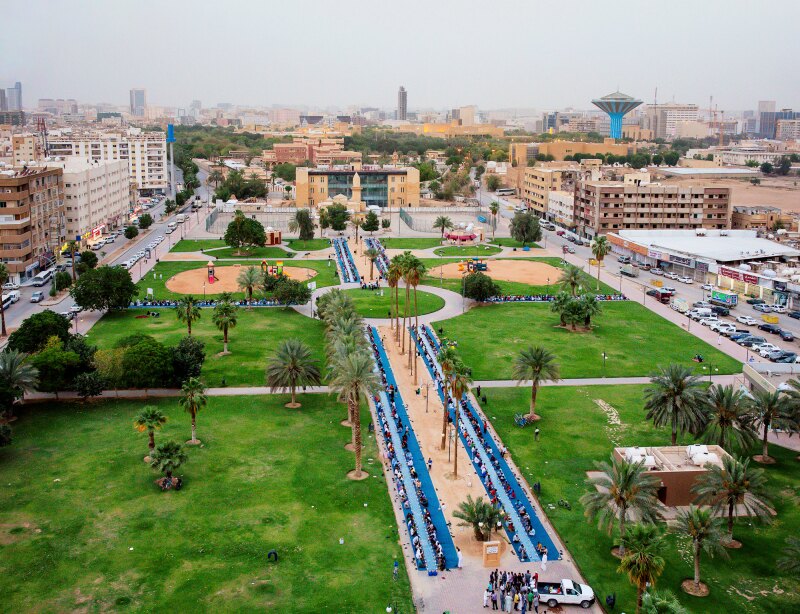
Hundreds of men gather in Riyadh to break their fast during Ramadan. Each day, an anonymous person will cover the expenses of the iftars.
Photo by Tasneem Alsultan











